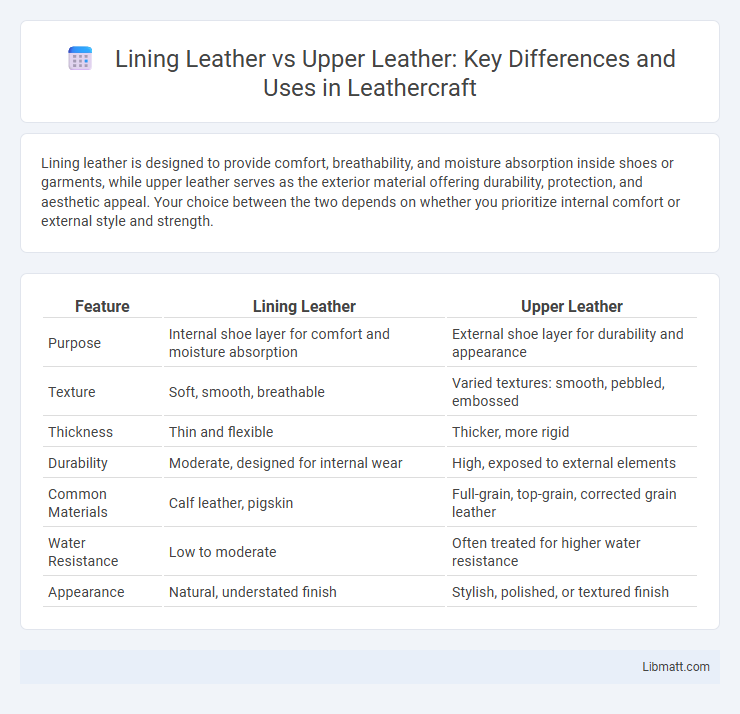Lining leather is designed to provide comfort, breathability, and moisture absorption inside shoes or garments, while upper leather serves as the exterior material offering durability, protection, and aesthetic appeal. Your choice between the two depends on whether you prioritize internal comfort or external style and strength.
Table of Comparison
| Feature | Lining Leather | Upper Leather |
|---|---|---|
| Purpose | Internal shoe layer for comfort and moisture absorption | External shoe layer for durability and appearance |
| Texture | Soft, smooth, breathable | Varied textures: smooth, pebbled, embossed |
| Thickness | Thin and flexible | Thicker, more rigid |
| Durability | Moderate, designed for internal wear | High, exposed to external elements |
| Common Materials | Calf leather, pigskin | Full-grain, top-grain, corrected grain leather |
| Water Resistance | Low to moderate | Often treated for higher water resistance |
| Appearance | Natural, understated finish | Stylish, polished, or textured finish |
Introduction to Lining Leather and Upper Leather
Lining leather is crafted to provide comfort, breathability, and moisture absorption inside footwear or garments, often made from softer, thinner hides like calfskin or goat leather. Upper leather, conversely, forms the visible exterior of shoes or leather products, requiring durability, style, and protection, commonly using full-grain or corrected-grain leather types. Both lining leather and upper leather are selected based on functional properties tailored to their specific roles in leather goods manufacturing.
Key Differences Between Lining Leather and Upper Leather
Lining leather is typically thinner, softer, and more breathable, designed to provide comfort and moisture absorption inside footwear or garments, while upper leather is thicker, more durable, and treated for water resistance and aesthetic appeal, forming the external structure of the product. Upper leather often undergoes various finishing processes such as aniline or pigmented coatings to enhance appearance and protection, whereas lining leather focuses on smoothness and flexibility to prevent irritation against the skin. The choice of leather for lining versus upper depends on the balance between comfort requirements and durability standards in apparel or footwear manufacturing.
Functions and Roles in Footwear Construction
Lining leather provides comfort, breathability, and moisture absorption inside the footwear, ensuring your feet remain dry and comfortable during wear. Upper leather forms the external structure, offering durability, protection, and aesthetic appeal to the shoe's overall design. Both types of leather are essential in footwear construction, balancing support and comfort for optimal performance.
Common Types of Lining Leather
Common types of lining leather include full-grain leather, suede, and nubuck, each offering distinct textures and breathability to enhance comfort and durability. Full-grain leather lining provides strength and moisture resistance, while suede lining adds softness and a slight grip to keep your feet secure. Choosing the right lining leather affects the shoe's overall fit, moisture management, and long-term wearability.
Popular Types of Upper Leather
Popular types of upper leather include full-grain, top-grain, genuine, and corrected-grain leather, each offering unique durability, texture, and aesthetic qualities suited for various shoe styles. Full-grain leather is prized for its strength and natural appearance, while top-grain leather provides a smooth surface with some imperfections removed. Your choice of upper leather affects both the look and longevity of footwear, making it essential to consider these categories for optimal performance and style.
Material Sourcing and Processing Methods
Lining leather is typically sourced from softer, more flexible hides such as lamb or calf to ensure comfort and breathability inside footwear or garments, whereas upper leather usually comes from thicker, tougher hides like cowhide to provide durability and protection. The processing methods for lining leather emphasize minimal treatment to retain suppleness and moisture-wicking properties, while upper leather undergoes more intensive tanning and finishing processes to enhance resistance to wear, water, and environmental damage. Understanding these distinctions in material sourcing and processing methods can help you choose the right leather type tailored to your product's performance and comfort needs.
Durability and Wear Resistance Comparison
Lining leather typically offers enhanced breathability and comfort, but upper leather is generally more durable and wear-resistant due to its thicker, more robust fiber structure designed to withstand external elements. Upper leather is engineered for high abrasion resistance, making it suitable for parts of footwear or garments exposed to frequent friction and impact. Your choice between lining leather and upper leather should consider the balance between comfort and durability based on the intended use.
Comfort and Breathability Factors
Lining leather is typically softer and more breathable, enhancing Your comfort by allowing better air circulation inside the shoe. Upper leather, often thicker and sturdier, provides durability and protection but may sacrifice some breathability. Choosing shoes with high-quality lining leather can significantly improve moisture management and overall foot comfort.
Cost Implications: Lining vs. Upper Leather
Lining leather generally costs less than upper leather due to its lesser exposure to wear and lower quality requirements. Upper leather demands premium finishes and durability, increasing its price significantly compared to lining leather. Manufacturers balance cost implications by selecting upper leather for aesthetics and durability while opting for more economical lining leather to reduce overall production expenses.
Choosing the Right Leather for Your Product
Selecting the right leather between lining leather and upper leather significantly impacts product durability and comfort. Upper leather, typically thicker and more durable, provides structural support and aesthetic appeal, making it ideal for external surfaces. Lining leather offers softness and breathability, enhancing wearer comfort by reducing friction inside shoes or garments.
Lining leather vs upper leather Infographic

 libmatt.com
libmatt.com